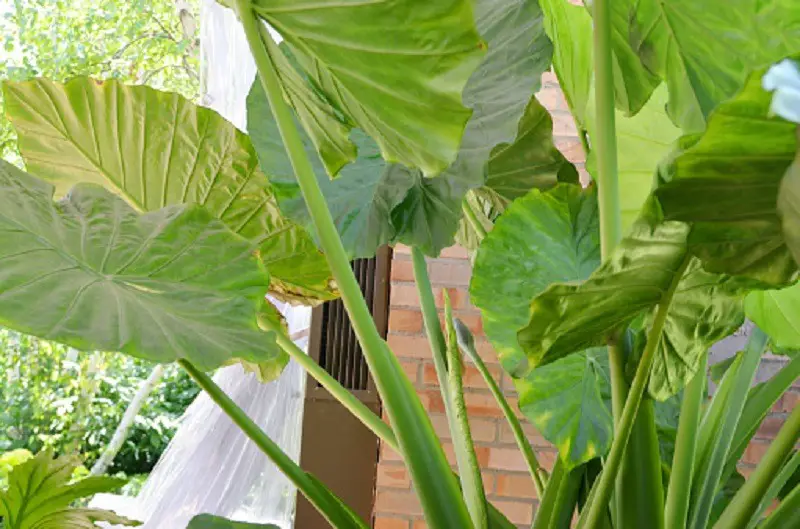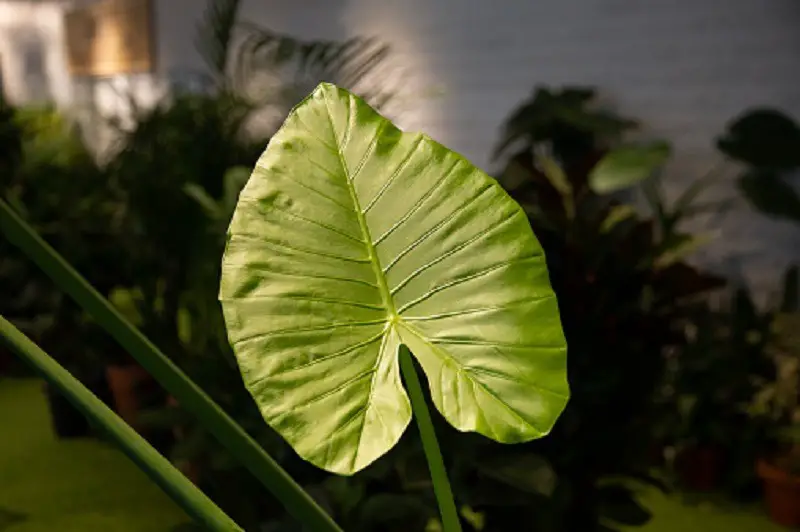Alocasias are rainforest plants native to Southeast Asia. Its lush beauty brings a tropical vibe to your home. Besides that, they are less susceptible to leaf problems.
But they are not invincible to common problems. Alocasia leaves turning brown and yellow happen to be the issues tossing the mind of many gardeners.
So, why are my alocasias leaves turning brown? The common culprits are sunburn, over-fertilization, overwatering, low humidity, rust spots, diseases, and more.
Identifying the cause of alocasia brown spots on leaves will help to fix it. The rule of thumb is to investigate your plant and identify the cause before resolving it.
This article digs into these issues to figure out the exact cause of alocasia leaves turning yellow and brown. Take time to read through it and learn how to fix alocasia silver dragon brown tips.
You May Also Like: Why Are My Alocasia Leaves Curling?

Causes of Alocasia Leaves Turning Brown
Underwatering Stress
The natural habitat of alocasia is rich in moisture. The high moisture content in the soil makes the plant develop stunning foliage that maintains its colors for a long.
But underwatered alocasia tends to wither, drooping leaves, and die. If you notice your alocasia leaves turning brown, it could be due to under-watering.
Investigate the potting mix by inserting your index finger. If the topsoil is dry, consider watering your plant to revive the beautiful foliages.
Water the houseplant once in the morning to foster hydration. Hydrated alocasia will not experience any leaf problems.
Stick to a healthy watering routine to avoid overwatering. A damp environment makes alocasia plants develop root rot that might cause other leaf issues.
Water alocasia once in a month during winter since the growth is dormant. I recommend watering the houseplant twice or thrice a month during spring and summer.
Over-Fertilization Issue
We have the desire to grow and maintain a healthy houseplant. Proper plant feeding helps to foster better growth and health.
But most gardeners usually overdo the feeding routine. Keep in mind that alocasia plants are not heavy feeders like other outdoor plants.
If you notice your alocasia leaves turning brown, it is due to excess buildup of fertilizer salts around the roots. These chemical compounds inhibit the roots from undertaking their functions.
I recommend flushing out the potting mix with plenty of distilled water. It will help to get rid of salt buildup around the roots.
You can also consider re-potting the houseplant. It is the best practice since it reduces the risks of overwatering your houseplant.
Apply fertilizer once a month during spring and summer. Avoid fertilizing your houseplant in winter since the growth is dormant. The plant will not fully utilize the fertilizer nutrients.
You May Also Read: How to Care for Alocasia Black Velvet
Nutrients Deficiency
The native habitat of alocasia plants is rich in nutrients. The plant can survive and thrive without the need for fertilization.
But the indoor environment does not provide essential nutrients naturally. The gardener needs to fertilize the houseplant once a month to provide the necessary nutrients.
Alocasia leaves that turn brown could be due to a lack of nitrogen, zinc, iron, and magnesium. The plant will also experience stunted growth, chlorosis, necrosis, and mottling.
Use a dilute growth fertilizer to revive your alocasia plant. Remember to apply the fertilizer during the growing season only. It will help to avoid the accumulation of toxic fertilizer salt.
You can also use a fresh organic mix to resolve the browning alocasia leaves. It is the best practice to prevent nutrient deficiencies in your houseplant.
You May Also Enjoy: Why Is My Alocasia Zebrina Drooping?
Cold Drafts
Cold drafts happen to be the leading cause of alocasia leaves turning brown. These tropical plants thrive in warmer conditions.
Cold drafts result in frostbite, and this condition ends up damaging the alocasia foliages. The leaf cells usually hibernate and get denatured if the condition persists for an extended period.
Frostbites result in bumpy brown spots on the leaves. The condition usually shocks the plant and causes vital tissue damages in the leaves.
The best practice is to keep the houseplant away from cold drafts. Consider sealing all the windows during winter to create a conducive environment for alocasia plants.
Low Humidity
Alocasia plants prefer warm and humid conditions. These tropical plants display their stress on the foliage in case of humidity changes.
Alocasia leaves drooping and turning brown are initial signs of low humidity. Dry air usually discolors the leaves in the long run.
Low humidity is common in winter, and it causes little moisture in the air. Alocasia crispy leaves are other signs of low humidity.
Install a convection heating system at home to help revive the houseplant. Keep in mind that excess humidity can also cause adverse effects.
Alocasia leaves are susceptible to fungal diseases and edema when exposed to excess humidity. These conditions could also be the reason behind the alocasia leaves turning brown and yellow.
Temperature Stress
Alocasia plants thrive in a temperature range of 64-85oF. The condition allows the plant to develop stunning leaves that make a bold statement in any room.
But maintaining the temperature at home can be a daunting experience. The indoor temperature is dynamic, and this can pose a health threat to your plant.
Both hot and cold drafts can shock your houseplant. These extreme temperatures cause vital tissue damages in the plant and facilitate the browning of leaves.
Many gardeners freak out when they notice elephant ear leaves turning yellow and brown. But there is no need to worry since the issue can be fixed by adjusting the indoor temperature.
Use a digital thermometer to help detect the temperature changes. Try to ensure the indoor temperature is below 60oF at night and about 70oF during the day.
You can also keep your alocasia plant away from heaters, cooling vents, and unsealed windows. It will help to prevent alocasia leaves from turning black and becoming droopy.
Low Lighting Condition
Alocasia plants love bright indirect sunlight. The exposure allows the houseplant to undertake photosynthesis and other vital physiological processes.
Low lighting condition is an indirect cause of brown leaves. The condition causes stunted growth and increases the risk of root rot and nutrient deficiencies.
Alocasia leaves turning brown is a sign of displeasure. The best option is to install strong artificial lights or place the plant in a location that receives plenty of indirect light.
You May Also Like: Why Is My Alocasia Polly Dying?
Insect Infestation
Insect infestation is another common cause of alocasia leaves turning brown. Mealybugs are the main culprits responsible for damaging the alocasia foliage.
These insects attack the stems and leaves. They suck cell sap by piercing the foliage and end up damaging the tissues. Insect infestation results in alocasia brown spots on leaves.
Other pests that attack alocasia are spider mites, aphids, and scales. Always inspect your houseplant more often to prevent excessive pest infestation.
Use either insecticidal soap or horticulture oil to get rid of these insects. Regular application of horticulture oil helps to prevent insect infestations on houseplants.
Plant Diseases
Alocasia plants are less susceptible to diseases. But this does not imply that the houseplant is immune to common diseases.
Alocasia leaves turning brown could be due to fungal diseases. The conditions usually result in alocasia brown spots on leaves.
The bacteria leaf spot occurs due to a wet environment. Always avoid watering your plant from the top to prevent the occurrence of fungal diseases.
Use anti-fungal and antibacterial sprays to treat the brown alocasia leaves. Isolate the plant from other houseplants to prevent the spread of the disease.
You May Also Like: Why Are My Alocasia Polly Turning Yellow?
Overwatering Issue
Overwatering is the leading cause of yellow and brown alocasia leaves. The issue occurs due to improper soil drainage.
Soggy soil creates a conducive environment for the development of root rot. It hinders root aeration and absorption of vital nutrients and water.
Alocasia leaves turning yellow and brown are the indicators of overwatering. The best option is to treat the fungal infection to prevent the spread and combat the browning of leaves.
I recommend re-potting the houseplant to a fresh potting mix. Cut off the affected roots and leaves and provide a better growing condition.
Direct Sunlight Exposure
Alocasias are native to the tropical rainforest in Southeast Asia. The canopy provides a shade to the plants to prevent direct sunlight exposure.
If you notice your indoor alocasia leaves turning brown, it could be due to sunburn. Direct sunlight exposure usually burns the alocasia leaves.
Alocasia leaves drooping, and curling is another possible sign of sunburn. The condition can also cause alocasia silver dragon brown tips.
Keep your houseplant away from direct sunlight. I recommend using artificial lights rather than placing the indoor plant in a region that receives direct sunlight rays.
You Might Also Like: 20 Beautiful Alocasia Varieties with Names and Pictures

Final Thoughts
Alocasia leaves turning brown are due to bacterial leaf blight, direct sunlight exposure, low humidity, under-watering, and pest infestations.
Treating these conditions can help to revive your houseplant. There is no need to freak out since the issues can be prevented and treated.
I recommend observing a healthy watering routine, proper fertilizer application, and providing an ideal humidity level. These measures will help to prevent alocasia leaves from turning brown.
You Can Also Read: Why Is My Pilea Drooping?
More Sources and References
- Contributor. Elephant Ear Leaf Problems. University of Florida.
- Gail Hansen. Elephant Ear Plant. IFAS Extension.
- Editor. Alocasia Leaf Issues. Home Guides.
